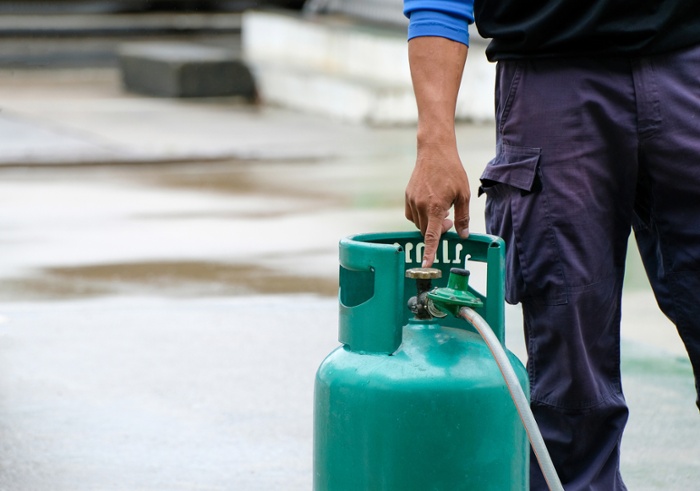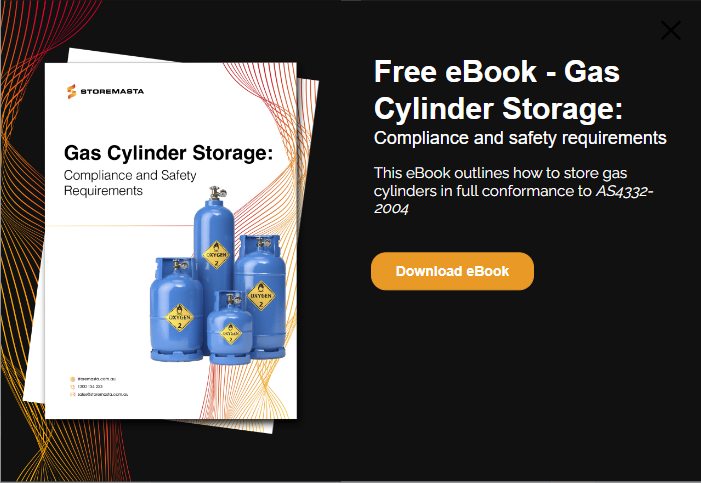Do your staff know how to safely handle gas cylinders to mitigate the risks of ruptured cylinders, ignition, gas leaks and human harm? This post highlights some key considerations when training staff to handle gas cylinders correctly. We’ll outline some training methods to assist with gas cylinder safety, as well as the training required to meet the requirements of the Australian Standard.
REMEMBER: The WHS Regulations explain that supervision, information, training and instruction are required under regulation 39 for workplaces that are using, handling, generating or storing a hazardous chemical.
What is Gas Bottle Handling?
Handling refers to the physical tasks associated with the use and storage of Class 2 gas cylinders.
In a workplace, there may be many reasons that staff are required to handle gas bottles including moving the items into storage, refilling gas bottles, swapping out empty gas cylinders and connecting bottles.
When gas cylinders are being used, stored or moved throughout the workplace, it can lead to hazardous situations if proper gas bottle handling procedures aren’t being followed. Physical hazards (ie. manual lifting injuries) and chemical hazards (ie. asphyxiation from leaking toxic gases) can occur if there aren’t the correct handling procedures and training in place.

Gas bottle handling must be done in a way that ensures health and safety for your people and wider community.
Australian Standards for Gas Cylinders
There are strict requirements in Australia for the safe handling of gas cylinders. The Australian Standard AS 4332 - The storage and handling of gases in cylinders outlines a number of minimum requirements to reduce the risk of injuries, deaths and workplace accidents.
To fully comply with the Standard and ensure safe gas bottle handling, your workplace may need safety equipment to control risk.
Some examples of equipment to improve safety with gas handling may include:
- Gas cylinder lifting devices
- Gas bottle trolleys
- Gas bottle cages with individual cylinder restraints
- Personal protective equipment such as insulated gloves and breathing apparatus
However, your gas cylinder storge and handling equipment is only effective if staff are trained on how to use it properly.
WHS Training Needs For Staff
Training for staff is essential to ensure health and safety onsite. However, workplaces that are carrying dangerous goods, such as gas bottles and cylinders, must implement a range of WHS training courses so staff can safely work with these hazardous chemicals.
- Safety inductions
- Job skills training
- Emergency response training
Safety Inductions for Gas Bottle Handling
Safety training usually begins with induction training where personnel learn the safety rules of the site. This training will include an introduction to the safety risks and hazards they are likely to encounter while working there.
Preliminary inductions are often delivered online before a worker or contractor starts their initial duties — and a more comprehensive induction delivered when they arrive onsite.
Induction training for gas cylinder handling may include:
- The types of gases used on-site, cylinder sizes and where they are located
- The chemical properties of the gases and how the worker or contractor could be harmed
- The applicable safety regulations and the responsibilities of the worker/contactor
- An introduction to safe handling procedures
- Location of safety data sheets, first aid equipment and safety equipment
- How to respond to an emergency situation
Safety inductions are not considered a complete training program in themselves. Therefore, they should be followed up with comprehensive one-on-one training that includes job skills and work methods.
Job Skills Training
After their safety induction, new staff and contractors should be familiar with the site layout and the gas cylinders they will be handling. Now is the time to give them specific training to handle the cylinders correctly.
Depending on the worksite, this gas bottle handling training might include:
- Receiving cylinders from transport companies - unloading with forklifts (or other mechanical lifting devices), checking labels and visually inspecting cylinders, safely transferring cylinders to the gas store, ensuring cylinders are upright and individually restrained, correctly segregating cylinders into hazard classes
- Transferring cylinders from stores to work areas - using gas bottle trolleys, preliminary safety checks valves closed, caps on, no leaks
- Securing gas cylinders while in use - keeping cylinders restrained on a trolley
- Using personal protective equipment – understanding what type of PPE to use, location of PPE, how to fit and use it correctly, cleaning and maintaining PPE
- Hazard training - how fires are started, ignition sources, asphyxiation hazards, toxic and corrosive gases, how oxidisers create fires and explosions, chemical reactions and incompatible substances
- First aid measures - location of first aid equipment and emergency showers, how to treat yourself, how to treat a co-worker, who to notify in the event of an accident
Effective job skills training involves a combination of auditory, visual and kinaesthetic learning where procedures would be explained as well as demonstrated. The student then performs the tasks under the supervision of the instructor who can then continue the training until the student is competent.
IMPORTANT: Safety training must consist of more than a set of written procedures handed to an employee for them to sign. Staff must be supervised handling gas cylinders correctly and consistently.
Supervision and Training Revision with Gas Cylinder Handling
Staff who handle gas cylinders and other dangerous goods require adequate supervision to ensure they are correctly following procedures and adhering to safe work methods.
When staff aren’t following gas cylinder handling procedures, it puts their lives in danger and jeopardises the safety of the entire worksite.
When staff aren’t following the correct gas bottle handling procedures, it may be an indication that:
- Team members don’t fully understand how to handle the gas cylinders correctly
- They aren’t completely aware of the chemical properties and hazards of the gases they are handling, so they don’t take the procedures seriously
- They have damaged or lost their PPE and are substituting something else because they are afraid to report it
- An outside contractor or different work team convinces them to deviate from work standards
- Critical handling and cylinder storage equipment is missing or broken so the staff improvise instead of following procedures
- Staff don’t know what to do when they encounter a situation ‘outside the box’
Very often these incidences of incorrect performance indicate a weakness in the work process that needs to be improved.
IMPORTANT: The standard requires that staff must be retrained whenever they have demonstrated substandard performance in safety procedures.
Emergency Response Training: Gas Bottles and Cylinders
Emergency response training is usually conducted annually and involves an evacuation drill. When you handle and store gas cylinders onsite you will need to conduct a risk assessment to analyse the types of dangerous events that could occur and then incorporate that into your emergency procedures and response training.
This would need to include gas bottle emergency response training for incidents including:
- Fires and explosions: how onsite gases in cylinders might cause and exacerbate a fire or explosion, what to do, who to call, what equipment to wear, how to evacuate.
- Gas leaks: initial response, PPE to wear, who to notify, evacuation procedures, cleanups, equipment repair.
- Chemical reactions: PPE to wear, kill switches and shutdown procedures, first aid procedures, using emergency showers, who to notify, evacuation procedures.
TIP: You can build gas cylinder safety awareness with your staff through regular gas bottle tool box talks and workplace safety forums.
Safely Handling and Storing Gas Bottles
If your workplace handles and stores gas cylinders why not download our free eBook Gas Cylinder Storage: Compliance and safety requirements. The easy-to-read eBook outlines the requirements of AS 4332 - The storage and handling of gases in cylinders uses real-world examples and case studies to make gas bottle safety relevant for your team. Get your copy today and raise gas bottle safety awareness in your workplace.
Joining the team as a Dangerous Goods Storage Consultant, Melissa Hampton became Storemasta's Marketing Manager in late 2021. With extensive knowledge and experience in chemical compliance, Melissa is responsible for leading the Marketing team and helping shape their marketing strategy. In her spare time, you can find Melissa hiking, swimming and enjoying the great outdoors in beautiful north-west Tasmania.

